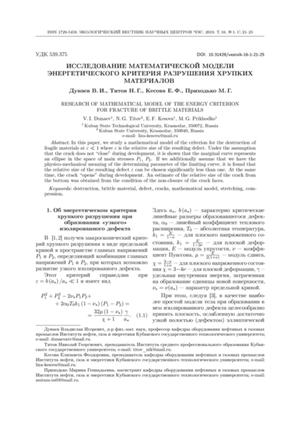Research of mathematical model of the energy criterion for fracture of brittle materials
UDC
539.375EDN
ZARBWXDOI:
10.31429/vestnik-16-1-21-25Abstract
In this paper, we study a mathematical model of the criterion for the destruction of fragile materials at $\varepsilon \ll 1$ where $\varepsilon $ is the relative size of the resulting defect. Under the assumption that the crack does not "close" during development,
it is shown that the marginal curve represents an ellipse in the space of main stresses $P_{1}$, $P_{2}$. If we additionally assume that we have the physico-mechanical meaning of the determining parameter of the limiting curve, it is found that the relative size of the resulting defect $\varepsilon $ can be chosen significantly less than one. At the same time, the crack "opens" during development. An estimate of the relative size of the crack from the bottom was obtained from the condition of the non-closure of the crack faces.
Keywords:
destruction, brittle material, defect, cracks, mathematical model, stretching, compressionReferences
- Дунаев И.М., Дунаев В.И. Об энергетическом условии разрушения твёрдых тел // ДАН. 2000. Т. 372. № 1. С. 43–45. [Dunaev, I.M., Dunaev, V.I. On the energy condition for fracture of solids. Proc. of Physics, 2000, vol. 372, no. 1, pp. 43–45. (In Russian)]
- Дунаев И.М., Дунаев В.И. Энергетическое условие разрушения твёрдых тел // Механика твёрдого тела. 2003. № 6. С. 69–81. [Dunaev, I.M., Dunaev, V.I. Energy condition for fracture of solids. Mechanics of solids, 2003, no. 6, pp. 69–81. (In Russian)]
- Дунаев В.И., Молдованов С.Ю., Лозовой С.Б, Георгияди В.Г. Хрупкое разрушение материалов при развитии "узких" изолированных дефектов // Экологический вестник научных центров черноморского экономического сотрудничества. 2015. №3. С. 26–37. [Dunaev, V.I., Moldavanov, S.Yu., Lozova, S.B., Georgiadi, V.G. Fragile destruction of materials in the development of "narrow" isolated defects. Ecological Bulletin of the scientific centers of the black sea economic cooperation, 2015, no. 3, pp. 26–37. (In Russian)]
- Dunaev I.M., Dunaev V.I. Macroscopic Criterion for Brittle Fructure of Solids // Proc. Of the 7-th EVROMECH. Solid Mechanics Conference 2009. Portugal, Lisbon. P. 117–118.
- Ильюшин А.А., Ленский Б.С. Сопротивление материалов. М.: Гос. из-во физ.-мат. лит., 1959. 371 с. [Ilyushin, A.A., Lenski, B.S. Mechanics of materials. GOS. iz-vo Fiz.-Mat. lit., Moscow, 1959. (In Russian)]
- Мусхелишвили Н.И. Некоторые основные задачи математической теории упругости. М.: Наука, 1966. 707 с. [Muskhelishvili, N.A. Some basic problems of mathematical theory of elasticity. Nauka, Moscow, 1966. (In Russian)]
Downloads

Downloads
Dates
Submitted
Accepted
Published
How to Cite
License
Copyright (c) 2019 Дунаев В.И., Титов Н.Г., Кесова Е.Ф., Приходько М.Г.

This work is licensed under a Creative Commons Attribution 4.0 International License.


